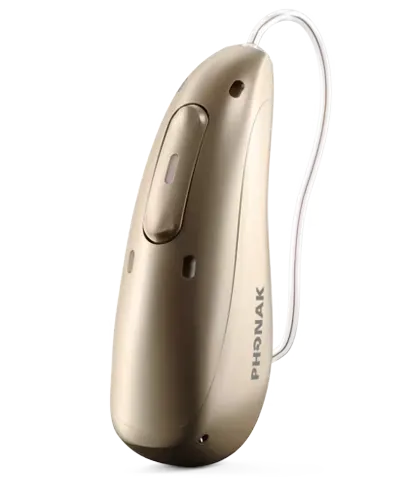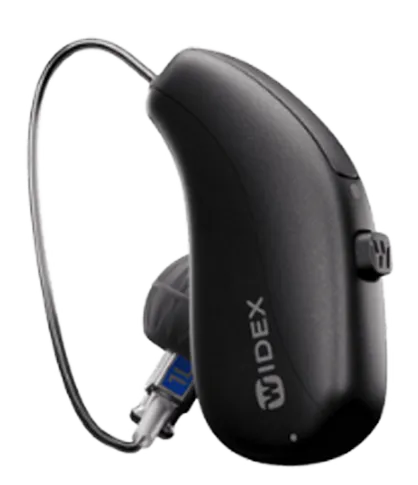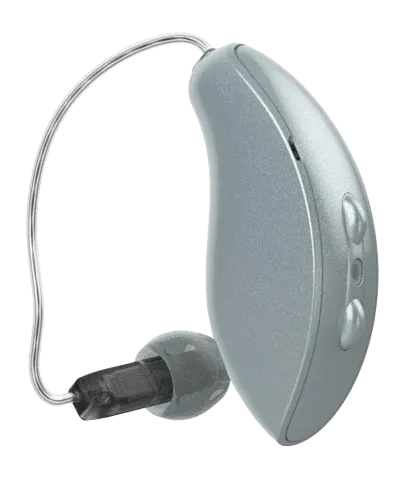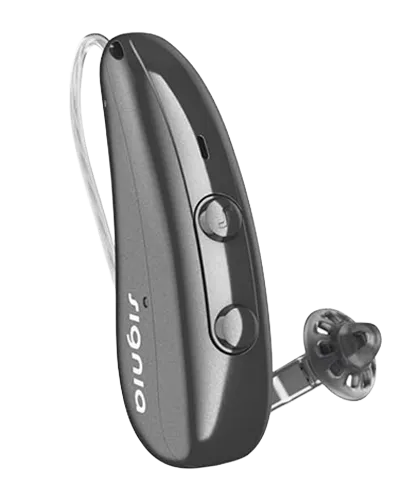





Advanced Hearing Aid Technology in Midland, Texas
Hearing aids are no longer the big, bulky or unsightly things they used to be. today, you can expect your hearing devices to be discreet, comfortable, and at the very top level of available technology developments.
Modern hearing devices go beyond just making things louder for you. They also bring a huge increase in your general wellbeing, and your ability to enjoy life in the way you deserve.
At All About Hearing, you can discover the latest in hearing aid technology. We offer a wide selection of prescription hearing aids from leading brands, including Phonak, Oticon, Siemens, Signia, Widex, Starkey, and Unitron.
What Are The Different Styles?
Behind-the-Ear (BTE) Hearing Aid Styles


Traditional BTE Hearing Aids
BTE hearing aids are known for their processing unit that rests behind the ear. Unlike older models, modern BTEs use digital technology to process sound. The processed sound is transmitted to the outer ear in various ways, depending on the specific style. BTE hearing aids typically offer greater processing power than In-the-Ear (ITE) devices and often include manual programming buttons and/or dials.
BTE with Earmold
This style features a longer-shaped processor that can house additional processing components. A key feature is the use of acoustical tubing to deliver processed sound to an earmold. The earmold can be quick-fit or custom-formed to match the contours of the outer ear canal.
Mini BTE with Slim Tube and Tip
A smaller version of the traditional BTE, mini BTEs hide behind the outer ear and use ultra-thin tubing to route sound discreetly to the ear. Instead of an earmold that occludes the ear canal, this style uses a soft tip that sits in the ear canal but does not occlude it. Known as “open fitting,” this allows natural airflow and sound to enter the ear around the tip while amplified sound enters through it.
Receiver-in-Canal (RIC) / Receiver-in-the-Ear (RITE)
Similar to BTEs and mini BTEs, RIC and RITE models place the speaker of the instrument in the earmold or ear tip rather than in the main body of the device. Processed sound is transmitted from the processor to the speaker
In-the-Ear (ITE) Hearing Aid Styles


In-the-Ear Hearing Aids
ITE hearing aids contain both the processing unit and the speaker within a single housing. These devices vary in size and are positioned differently in the ear canal. One advantage of ITE devices is that they do not interfere with glasses, oxygen cannula, or headwear. They also offer a more secure fit for active individuals and provide greater wearing discretion.
BTE with Earmold
These are the most powerful ITE hearing instruments and sit flush within the outer ear bowl. Their larger size allows for additional controls and features like directional microphones and larger batteries, which offer longer battery life. These benefits become limited or disappear as the size of the ITE device diminishes.
In-the-Canal (ITC)
ITC instruments sit inside the lower portion of the outer ear bowl, offering greater comfort and security. Slightly larger than Completely-In-The-Canal (CIC) models, they have a longer battery life and can include additional features like directional microphones for improved speech clarity in noisy environments and manual controls.
Completely-In-The-Canal (CIC)
CIC devices are smaller custom ITE devices that fit deeply and entirely within the ear canal, making them almost invisible. While they offer discrete and secure wearing, they lack some features of larger devices. Insertion, extraction, and handling can be challenging for those with manual dexterity or visual challenges.
features such as:
Bluetooth connectivity for seamless audio streaming from your devices
Rechargeable batteries for convenience and eco-friendliness
Custom-fitted designs for maximum comfort and effectiveness
Advanced noise reduction and feedback management for clear hearing in various environments
Invisible-in-canal (IIC) designs, and other discreet styles, for those concerned about aesthetics
The Benefits of Prescription Hearing Aids for You
Why getting your hearing aids expertly prescribed and fitted isn’t the end of your journey
Your hearing aid requirements are as unique as you are, and our team will make sure you get the correct devices, set up just as you need them to be in order for you to be able to live life to its fullest.
Our experts will make sure you get a personalized hearing solution tailored to your specific hearing loss and lifestyle.
We will also ensure your hearing aid fitting means that your devices are comfortable and provide the best possible performance.
Hearing Aids We Provide
At All About Hearing, we partner with all major hearing aid manufacturers to provide you with access to the latest technology from leading brands. This independence allows us to match you with the hearing aids that best fit your specific needs and lifestyle, rather than limiting your options.

Phonak Infinio
Next-generation hearing technology featuring ERA chip processing and enhanced speech clarity across all listening environments.
Oticon Intent
Advanced hearing technology that recognizes your listening intentions and adapts in real time to deliver natural sound quality.

Signia IX
Intelligent hearing technology that processes multiple conversations simultaneously while adapting to your unique sound preferences.

Widex Allure
Hearing technology that delivers pure, natural sound through advanced processing and exceptional streaming capabilities.

Starkey Omega AI
Hearing technology powered by artificial intelligence that learns your preferences and adapts to your lifestyle automatically.

ReSound Vivia
Hearing technology that delivers clear, comfortable sound with organic processing and seamless wireless connectivity.

Unitron Smile
Hearing technology designed for clarity in conversations with intuitive controls and reliable performance.
Hearing loss will often creep up without you really noticing. If you find it difficult to join in conversations, especially in noisy environments, it can be a sure sign that your hearing needs a little help. In fact, usually it will be your friends and family who know you have hearing loss before you do. If they keep mentioning it, it is likely they are absolutely right.
The first step in determining if hearing aids are right for you is to undergo a comprehensive hearing assessment.
Unfortunately, there is no cure for hearing loss, but hearing aids can get you back to a level where difficulties you've been experiencing become a thing of the past.
Hearing devices assist your natural hearing by processing sound to clarify and amplify it, but they cannot restore the natural function of your ears. Hearing aids can also slow the rate of your hearing deterioration, limit cognitive decline, alleviate tinnitus symptoms, and help correct balance and vertigo issues.
Prescription hearing aids are customized and fitted by hearing care professionals, providing better sound quality and more advanced features. This is continued with ongoing aftercare to make sure your hearing aids are always at their best, and personalized to your specific hearing needs.
Buying over-the-counter hearing aids is no different to buying any electrical item. Once you get home, unless there's a fault, you will be pretty much on your own in figuring out how to get the best from the devices.
Prices can vary based on technology and features of any hearing aids, but our team will make sure you get what you need based on your circumstances, and will discuss all options with you.
Buying over-the-counter hearing aids is no different to buying any electrical item. Once you get home, unless there's a fault, you will be pretty much on your own in figuring out how to get the best from the devices.
The settling in period for hearing aids will vary for each individual, as your brain undergoes a period of adjustment as it acclimatizes to the processed sounds it maybe hasn’t heard in a while. You will hear improvements almost immediately, but it can take just a little time for your brain to figure out the changes it is suddenly experiencing.
Your hearing care expert will offer programming adjustments, technical support, troubleshooting, and coping strategies to help speed up the adjustment process and make it as smooth as possible.
It very much depends on both your insurance provider and your specific plan. Some plans cover all costs from hearing tests to hearing aids, whilst others cover some items and not others. There may also be deductibles or other exclusions to take into account.
We highly recommend you chack your plan, and our insurance experts can help you to navigate the often complex world of health insurance.
About Hearing Aid Technology
Request a callback
It’s often the small questions and concerns that hold us back from making positive decisions – especially when it comes to your hearing health.
That’s why we offer no-obligation friendly calls to help answer those questions, whether on behalf of yourself or a loved one.
Simply complete the form and a member of our team will call you back shortly.
Don’t want to wait? Call us at: (432) 689-2220
